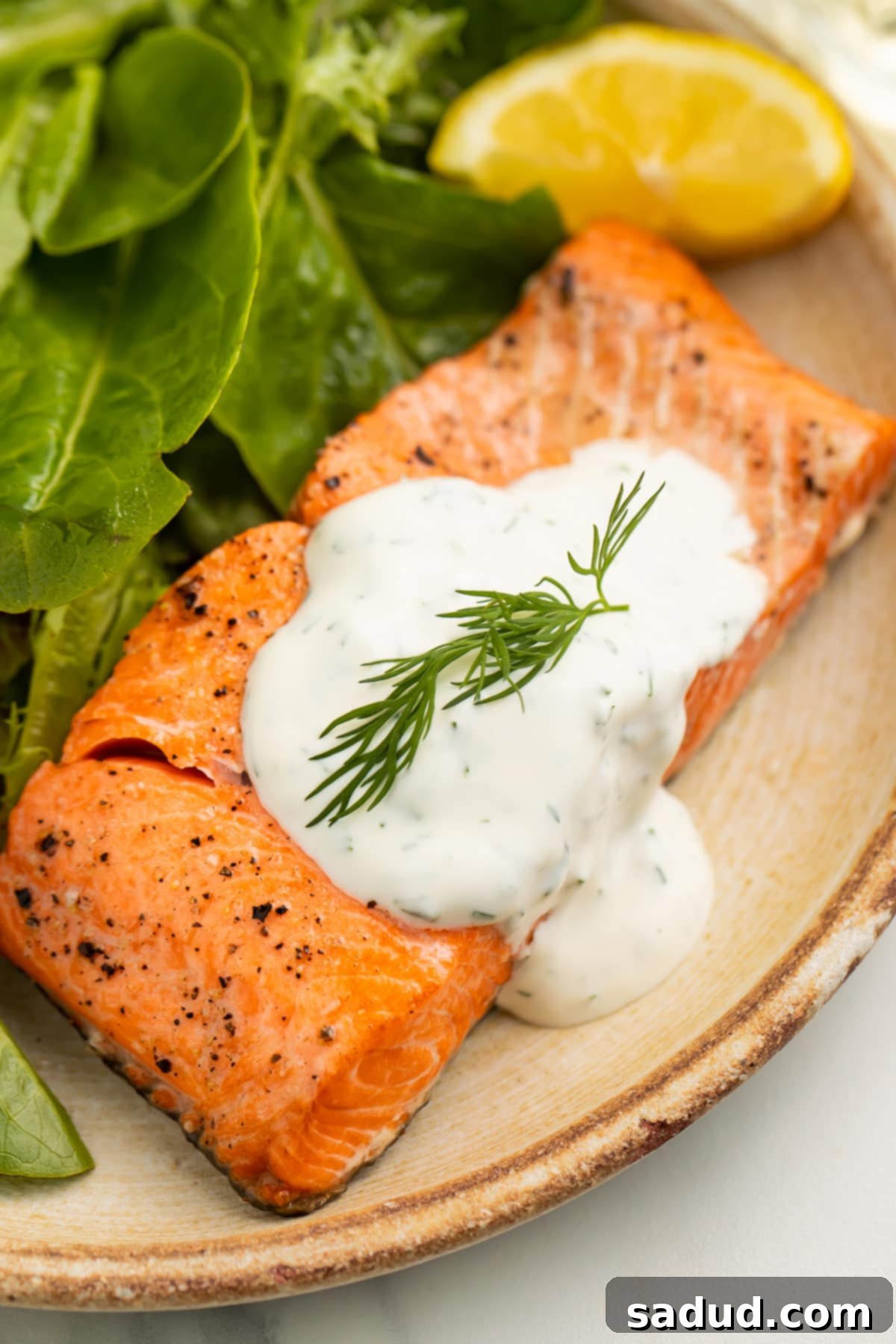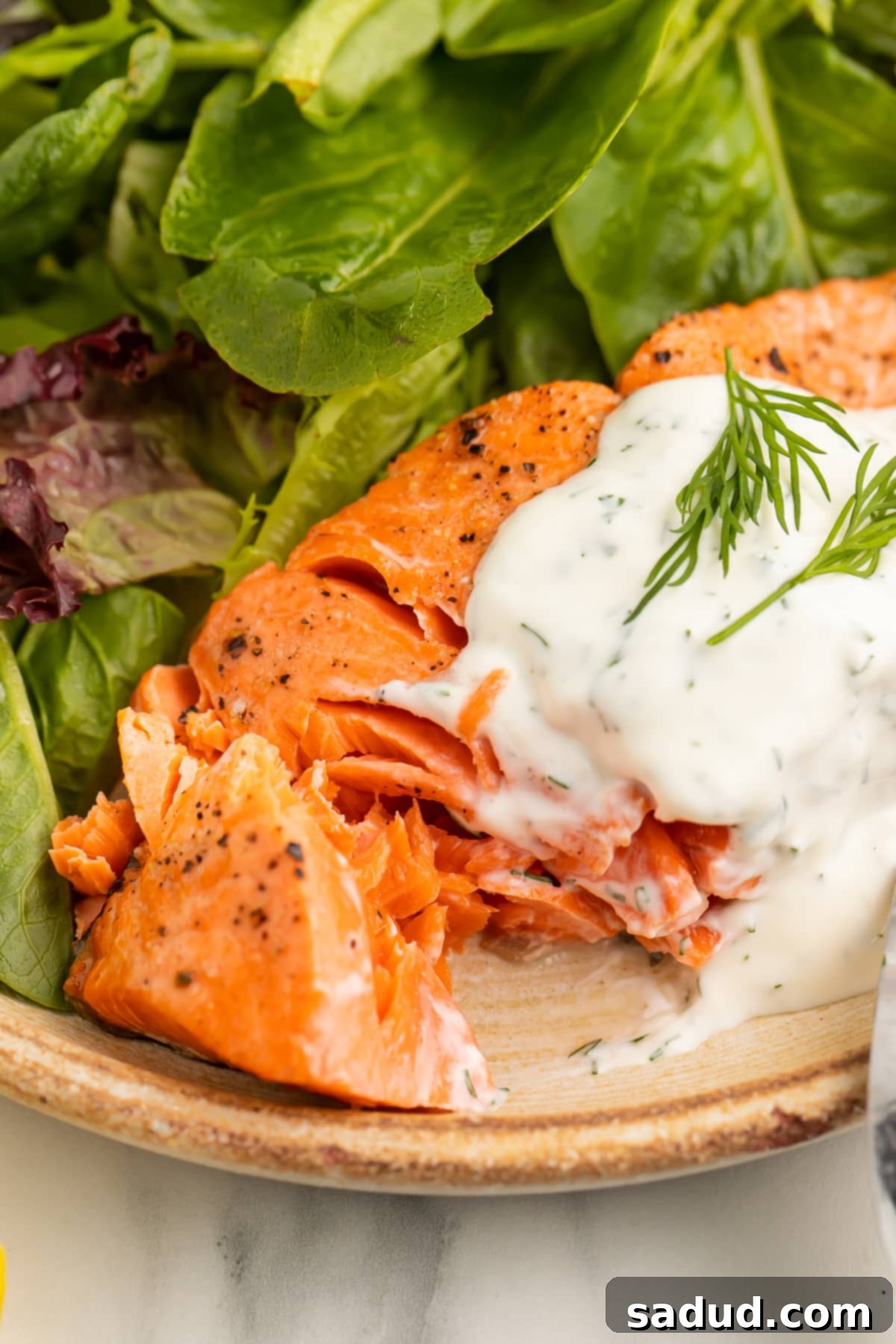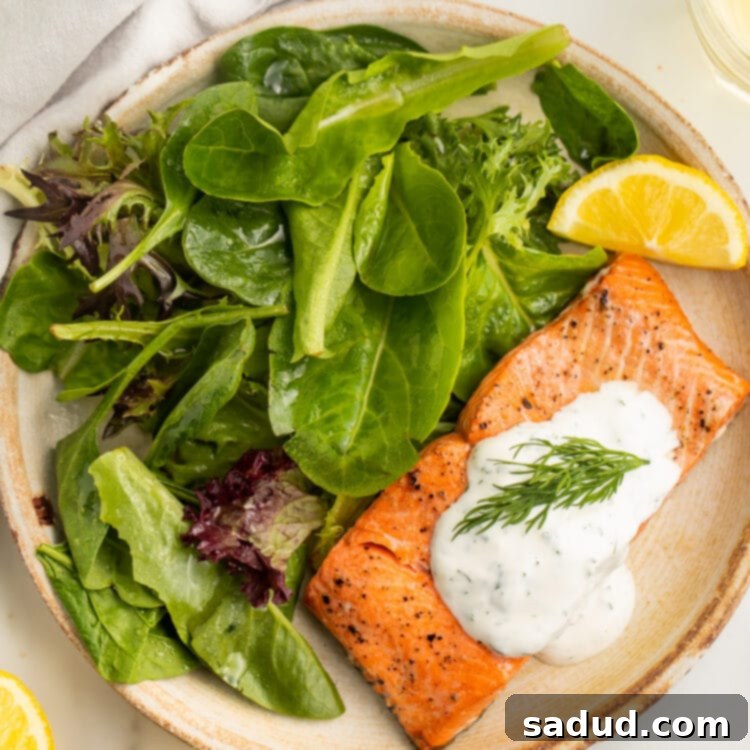Perfect 10-Minute Air Fryer Salmon: Your Ultimate Guide to Flaky, Flavorful & Fast Fish
Imagine ultra-tender, beautifully flaky, and perfectly cooked salmon ready to grace your dinner table in roughly 10 minutes. This culinary dream becomes a delicious reality, all thanks to the magic of the air fryer. Once you experience the sheer ease and incredible results of air fryer salmon, we promise you’ll be hard-pressed to prepare this beloved fish any other way ever again. It’s truly a game-changer for busy weeknights, quick lunches, or whenever you crave a healthy, satisfying meal without the fuss.

🐟 Why Air Fryer Salmon is Your New Go-To Recipe
Cooking salmon in an air fryer isn’t just a method; it’s a revelation. This recipe stands out for multiple compelling reasons, making it a staple in any modern kitchen:
- Unbeatable Speed & Convenience: Air fryer salmon is remarkably simple, wonderfully light, and incredibly delicious. But its standout feature is its speed. We’re talking about a meal that is ready to eat in as little as 10 minutes from start to finish. This makes it an ideal choice for hectic weeknights, last-minute meal prep, or whenever you need a wholesome, protein-packed dish in a flash. After just a few minutes, you’re rewarded with impeccably flaky, tender, and moist salmon fillets every single time. We particularly love serving them alongside our creamy dill sauce – a pairing that truly is a match made in culinary heaven, elevating the natural flavors of the salmon.
- Effortless Cleanup & Minimal Mess: There are countless advantages to air fryer cooking, but two of our absolute favorites revolve around kitchen comfort and cleanliness. Firstly, you don’t have to heat up your entire kitchen to cook a full meal, a blessing during warmer months or when you simply want to conserve energy. Secondly, any mess generated is wonderfully contained within the air fryer basket. While air fryer salmon is inherently a low-mess dish, this method eliminates the need for multiple pots, pans, and extra dishes often required by other cooking techniques like baking or pan-frying. This means less scrubbing and more time enjoying your meal!
- Perfect Texture Every Time: The air fryer excels at creating a beautiful texture. It cooks the salmon evenly, ensuring a moist interior while giving the exterior a delicate, slightly crispy finish. This balance is often hard to achieve with other cooking methods without careful monitoring, but the air fryer’s circulating hot air makes it almost foolproof.
- Health-Conscious Cooking: Salmon is a nutritional powerhouse, rich in omega-3 fatty acids, protein, and essential vitamins. The air frying method requires minimal oil, helping to maintain the health benefits of the salmon while delivering maximum flavor. It’s a fantastic way to enjoy lean protein without adding unnecessary fats.
👩🏼🍳 Chef’s Essential Tips for Flawless Air Fryer Salmon
While air fryer salmon is inherently straightforward, a few expert tips can elevate your results from great to truly exceptional. Follow these guidelines for consistently perfect, restaurant-quality fish:
- Timing is Everything – Remove Immediately: This is perhaps the most crucial tip for perfectly cooked salmon. Make sure you take the salmon fillets out of the air fryer basket literally the second they’re done cooking. Salmon cooks very quickly, and it’s incredibly easy to overcook. Even an extra minute of residual cooking within the hot air fryer basket can be enough to push your beautiful fillet over the doneness edge, especially if you prefer a specific texture or are particular about the delicate flakiness of your fish. Overcooked salmon quickly becomes dry and less enjoyable, so swift removal is key to preserving its succulence.
- Embrace the Internal Meat Thermometer: For absolute precision and peace of mind, we highly recommend using an internal meat thermometer to accurately gauge the doneness of your salmon. Relying solely on visual cues, such as the color of the meat or even its flakiness when probed with a fork, can be misleading. A thermometer provides an objective measure, ensuring your salmon is cooked exactly to your preferred level of doneness every time. We’ve included a handy internal temperature guide in the recipe card below, detailing the precise temperatures to aim for to achieve medium-rare, medium, medium-well, or well-done salmon. This tool is a small investment that guarantees consistently perfect results.
- Preheat Your Air Fryer: Just like an oven, preheating your air fryer is essential. It ensures the salmon starts cooking immediately upon contact with hot air, leading to a better sear on the outside and more even cooking throughout. Don’t skip this step – it only takes a few minutes but makes a big difference.
- Don’t Overcrowd the Basket: For optimal air circulation and even cooking, avoid cramming too many salmon fillets into your air fryer basket. Cook in batches if necessary, ensuring there’s enough space around each fillet for the hot air to circulate properly. This prevents steaming and promotes that desirable slightly crispy exterior.
- Choose the Right Oil and Seasoning: A light coating of avocado oil (or another high smoke point oil) helps the seasoning adhere, promotes a nice exterior, and prevents sticking. While we keep seasonings simple in this base recipe, feel free to experiment. Lemon pepper, garlic powder, paprika, or a touch of cayenne can all add wonderful dimensions of flavor.
- Skin-Side Down for Crispiness: If your salmon fillets have skin, placing them skin-side down in the air fryer basket helps to protect the flesh from drying out and allows the skin to crisp up beautifully. You can easily remove it after cooking if preferred, or enjoy the added texture!

Selecting the Best Salmon for Your Air Fryer
The quality of your salmon can significantly impact the final dish. Here’s what to look for when choosing your fillets:
- Fresh vs. Frozen: Fresh salmon is always a treat, but high-quality frozen salmon is an excellent and often more accessible option. If using frozen, remember to defrost it thoroughly overnight in the refrigerator before cooking. This ensures even cooking and prevents a rubbery texture.
- Type of Salmon: Different varieties of salmon have distinct flavor profiles and fat contents.
- Atlantic Salmon: This is the most commonly available farmed salmon, known for its mild flavor and rich, fatty texture, making it very forgiving to cook.
- Sockeye Salmon: Wild-caught, with a vibrant red color and stronger, richer flavor. It’s leaner than Atlantic salmon, so it requires a bit more care not to overcook.
- Coho Salmon: Another wild-caught option, offering a milder flavor than Sockeye and a firm texture.
- King (Chinook) Salmon: The largest and fattiest of the Pacific salmon, prized for its rich, buttery flavor and tender flesh.
Any of these varieties will work beautifully in the air fryer, just be mindful that leaner cuts may require slightly less cooking time.
- Fillet Thickness: Aim for fillets of relatively even thickness for consistent cooking. If some pieces are significantly thicker than others, they may require longer cooking, or you can gently butterfly thicker sections to promote evenness.
Creative Serving Suggestions for Air Fryer Salmon
While the creamy dill sauce is a fantastic accompaniment, don’t limit your options! Air fryer salmon is incredibly versatile and pairs well with a variety of sides and flavors:
- Classic Sides: Serve with steamed or roasted asparagus, broccoli, green beans, or a simple side salad for a light and healthy meal.
- Hearty Grains: Pair with quinoa, brown rice, couscous, or a lemon-herb rice pilaf to make it a more substantial dish.
- Lemon & Fresh Herbs: A squeeze of fresh lemon juice and a sprinkle of chopped fresh dill, parsley, or chives can brighten the flavor of the salmon beautifully.
- Roasted Vegetables: Sweet potato fries (also made in the air fryer!), roasted Brussels sprouts, or a medley of bell peppers and onions make excellent partners.
- Taco Tuesday Twist: Flake the cooked salmon and use it as a filling for fish tacos with a vibrant slaw and a squeeze of lime.
- Salmon Bowl: Create a healthy bowl with a base of greens or rice, topped with the salmon, avocado, cucumber, and a drizzle of sriracha mayo or a light vinaigrette.
Flavor Variations & Seasoning Ideas
This recipe uses a simple salt and pepper seasoning to highlight the salmon’s natural flavor, but the air fryer is perfect for experimenting with different flavor profiles:
- Lemon Herb Salmon: Before cooking, rub the salmon with olive oil, then season with lemon zest, dried dill, garlic powder, salt, and pepper.
- Spicy Garlic Salmon: Combine minced garlic, a pinch of red pepper flakes, olive oil, salt, and pepper. You can also add a dash of paprika for color and warmth.
- Sweet & Savory Glaze: Brush the salmon with a mixture of honey, soy sauce, minced ginger, and a touch of rice vinegar during the last 2-3 minutes of cooking for a beautiful glaze.
- Cajun Salmon: Use your favorite Cajun seasoning blend for a smoky, spicy kick. Ensure your seasoning blend doesn’t contain too much salt if you’re adding additional salt.
- Mediterranean Inspired: Season with oregano, thyme, garlic powder, salt, pepper, and a splash of lemon juice. Top with chopped olives and cherry tomatoes after cooking.
🥘 Other Delicious Recipes You Will Love
If you enjoy healthy, easy, and flavorful meals, be sure to explore these other fantastic recipes:
- Creamy Dill Sauce for Salmon – The perfect partner to your air fryer salmon!
- Tuna Carpaccio – A delicate and impressive appetizer.
- Keto Sushi Rolls with Smoked Salmon – A low-carb twist on a sushi favorite.
- Easy Salmon Patties & Lemon Garlic Sauce – Another great way to enjoy salmon.
- She Crab Soup – A rich and creamy seafood classic.
- Canned Tuna Nachos – A fun and unexpected snack or light meal.
- Whole30 Sushi – Spicy Salmon Roll (Low Carb, Paleo, Keto Friendly) – Healthy and flavorful sushi without the rice.
- Seafood Salad – A refreshing and versatile dish.
- The Best Lobster Bisque – Indulgent and utterly delicious.
- Tuna Ceviche – A bright and zesty seafood appetizer.
- Fish Taco Sauce – The perfect condiment for any fish taco creation.
If you loved this incredibly easy and delicious air fryer salmon recipe as much as we did, don’t forget to leave us a review below and share your experience! ★ Follow Easy Healthy Recipes on Pinterest, Facebook, and Instagram to discover more quick and healthy meal ideas!
For even more delicious and healthy recipes, be sure to visit our sister sites, 40 Aprons for paleo and Whole30 delights, and Easy Cheap Recipes for budget-friendly meal solutions.

10-Minute Air Fryer Salmon
 Cheryl Malik
Cheryl Malik
Print
SaveSaved!
Ingredients
- 2 4-ounce boneless salmon fillets
- 1 ½ teaspoons avocado oil
- ⅛ teaspoon sea salt more or less to taste
- ⅛ teaspoon freshly cracked black pepper more or less to taste
Equipment
-
Air Fryer
-
Cutting board or large plate for prep
-
Basting brush optional, for even oil distribution
-
Fork for checking flakiness
-
Internal meat thermometer optional, but highly recommended for perfect doneness
Instructions
-
Preheat Air Fryer: Begin by preheating your air fryer to 350° Fahrenheit (175°C). This crucial step ensures even cooking and helps achieve that desirable delicate crisp on the exterior of the salmon.
-
Prepare Salmon Fillets: Place your salmon fillets on a clean cutting board or a large plate. Drizzle or brush the avocado oil evenly over all sides of each fillet. This helps the seasonings adhere and promotes a beautiful texture. Next, season the salmon generously on all sides with sea salt and freshly cracked black pepper, adjusting quantities to your personal taste preference. Feel free to add any other desired spices at this stage.
-
Load Air Fryer: Once the air fryer has preheated to the specified temperature, carefully place the seasoned salmon fillets into the air fryer basket. For best results, position them skin-side down (if applicable) and ensure there’s enough space between the fillets for proper air circulation. Insert the basket firmly into the air fryer.
-
Cook & Check Doneness: Cook the salmon for an initial 3 minutes. After this time, gently remove the basket and check the doneness of the salmon. Continue cooking the salmon, checking every 1 minute thereafter, until your desired doneness is achieved. The salmon fillets should flake easily with a fork when done. For absolute precision, use an internal meat thermometer to verify the temperature. Refer to the “Notes” section below for approximate cook times and precise internal temperature guidelines for various doneness levels.
-
Rest & Serve: As soon as the salmon is cooked to your liking, immediately remove it from the air fryer to prevent overcooking from residual heat. Transfer the fillets to serving plates. Allow the salmon to rest for 3 to 5 minutes – this allows the juices to redistribute, ensuring a moist and flavorful result. Garnish as desired with fresh herbs, lemon wedges, or your favorite sauce, then serve hot and enjoy!
Notes
- Seasoning Flexibility: While we’ve opted for a simple salt and pepper seasoning in this recipe to let the natural flavor of the salmon shine, feel free to get creative! Lemon pepper, garlic powder, paprika, dried dill, or your favorite seafood seasoning blend would all be excellent choices. Adjust quantities to your taste.
- Variable Cook Times: Please note that actual cook times can vary significantly. Factors such as the specific model and wattage of your air fryer, as well as the initial temperature, size, and thickness of your salmon fillets, will all make a difference. Always use the provided times as a guideline and adjust as needed, checking frequently for doneness.
- Frozen Salmon: If you are starting with frozen salmon fillets, ensure they are fully defrosted before cooking. You can do this by transferring them to the refrigerator overnight or by using the cold water thawing method if you’re in a hurry. Cooking salmon from frozen in an air fryer is not recommended as it can result in uneven cooking and a less desirable texture.
- Leftovers Storage: To store leftover air fryer salmon, allow it to cool completely to room temperature. Then, transfer the salmon to an airtight container and refrigerate for up to 3 days. For best flavor and texture, gently reheat in the air fryer at a lower temperature (around 300°F / 150°C) for a few minutes until just warmed through, or enjoy cold in salads or sandwiches.
- Freezing Leftovers: If you wish to freeze cooked salmon, let it cool entirely first. Wrap each salmon fillet tightly in aluminum foil, then place the foiled fillets into a freezer-safe sealable bag. Remove as much air as possible from the bag before sealing. Frozen salmon can be stored for up to 3 months. Thaw overnight in the refrigerator before reheating.
Suggested Cook Times (Approximate for 4-ounce fillets)
These times are a guide. Always use a thermometer for precise results.
- Medium-Rare Salmon: 3 to 4 minutes
- Medium Salmon: 4 to 5 minutes
- Medium-Well Salmon: 5 to 6 minutes
- Well-Done Salmon: 6 to 7 minutes
Salmon Internal Temperature Guide (Recommended by USDA and culinary experts)
For the safest and most delicious results, aim for these temperatures:
- Medium-Rare: 115° to 120°F (46° to 49°C) – Very moist and slightly translucent in the center.
- Medium: 120° to 125°F (49° to 52°C) – Moist, with a slightly firmer texture and a faint pink center.
- Medium-Well: 125° to 140°F (52° to 60°C) – Cooked through but still very moist and flaky.
- Well Done: 140° to 150°F (60° to 66°C) – Firm, fully opaque, and flaky.
Nutrition Information
The number of total servings shown is an approximation. The actual number of servings will depend on your preferred portion sizes and how you divide the cooked salmon.
Nutritional values provided are general guidelines and reflect information for 1 serving based on the ingredients listed in this recipe card, and do not include any optional ingredients or additional garnishes. Actual macros may vary slightly depending on specific brands, types of ingredients used, and cooking variations.
To precisely determine the weight of one serving for your specific preparation, prepare the recipe as instructed. Weigh the total finished recipe (excluding the weight of the container or dish the food is in), then divide that total weight by your desired number of servings. The result will be the accurate weight of one serving.
